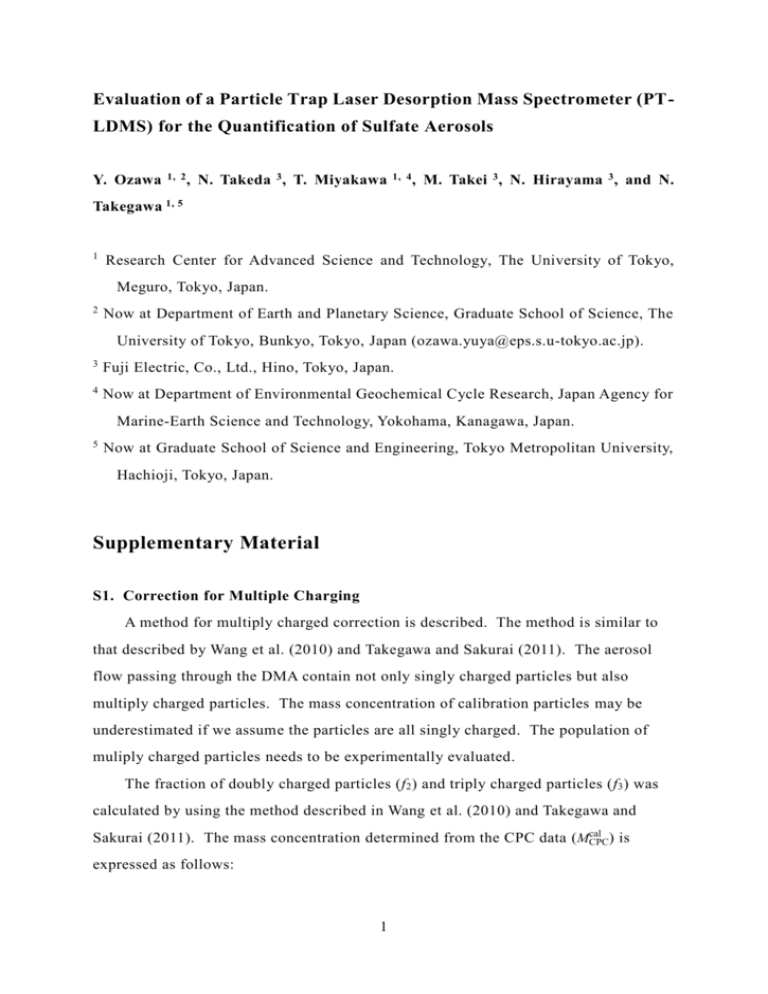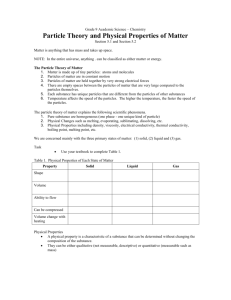Evaluation of a Particle Trap Laser Desorption Mass Spectrometer
advertisement

Evaluation of a Particle Trap Laser Desorption Mass Spectrometer (PTLDMS) for the Quantification of Sulfate Aerosols Y. Ozawa 1, 2 , N. Takeda 3 , T. Miyakawa 1, 4 , M. Takei 3 , N. Hirayama 3 , and N. Takegawa 1, 5 1 Research Center for Advanced Science and Technology, The University of Tokyo, Meguro, Tokyo, Japan. 2 Now at Department of Earth and Planetary Science, Graduate School of Science, The University of Tokyo, Bunkyo, Tokyo, Japan (ozawa.yuya@eps.s.u-tokyo.ac.jp). 3 Fuji Electric, Co., Ltd., Hino, Tokyo, Japan. 4 Now at Department of Environmental Geochemical Cycle Research, Japan Agency for Marine-Earth Science and Technology, Yokohama, Kanagawa, Japan. 5 Now at Graduate School of Science and Engineering, Tokyo Metropolitan University, Hachioji, Tokyo, Japan. Supplementary Material S1. Correction for Multiple Charging A method for multiply charged correction is described. The method is similar to that described by Wang et al. (2010) and Takegawa and Sakurai (2011). The aerosol flow passing through the DMA contain not only singly charged particles but also multiply charged particles. The mass concentration of calibration particles may be underestimated if we assume the particles are all singly charged. The population of muliply charged particles needs to be experimentally evaluated. The fraction of doubly charged particles (f 2 ) and triply charged particles (f3 ) was calculated by using the method described in Wang et al. (2010) and Takegawa and Sakurai (2011). The mass concentration determined from the CPC data (Mcal CPC ) is expressed as follows: 1 π 6 3 Mcal CPC = ρNd1 (1 - f2 - f3 + f2 d32 d31 d3 + f3 23 ) . d1 (S1) Where ρ is a particle density, N is the number concentration measured by the CPC, d1 is a particle diameter selected by DMA, d2 is the paricle diameter of doubly charged particles, and d 3 is the particle diameter of triply cherged particles. S2. KNO 3 The sensitivity for nitrate was measured under various Ttrap and Tcell conditions as well as sulfate. Figure S1 shows the evolution of the m/z 30 ion currents for KNO 3 particles obtained at a Ttrap of ~550°C and Tcell values of 200 and 280°C. For KNO 3 particles, the overall shape of the m/z 30 signal significantly changed in the earlier time period with increasing Tcell. The artifact signals were found be more pronounced for KNO3 than for (NH4 )2SO4 particles. Figure S2 shows the sensitivity experiment for KNO 3 . Although substantial scatter was observed in the data, the dependence of the sensitivity on Tcell also appeared to be more significant than the dependence on T trap for KNO 3. Higher T cell conditions exhibited lower sensitivity for KNO 3 particles.Changes in the temporal evolution of ion current and sensitivity depending on T cell were somewhat unexpected results. These features may not be explained by adsorption of NO on the cell wall. Further experiments are needed to investigate the mechanism. 2 3.0x10 -8 I30 (A) 2.0 2.0x10 -8 I30 (A) m/z 30 ion current for KNO3 Tcell = 280°C KNO3 Zero Tcell = 200°C KNO3 Zero 1.0 1.0 0.0 0 50 0.0 150 100 Elapsed time (s) Figure S1. The evaluation of mass normalized m/z 30 ion current for KNO 3 particles obtained at a Ttrap of ~550°C and T cell values of 200°C (blue and light blue lines, right axis) and 280°C (red and orange lines, left axis). 4 -1 S30 of KNO3 (pC ng ) 1.2x10 (b) Sensitivity for KNO3 Tcell = 280 °C Tcell = 200 °C 1.0 0.8 0.6 360 400 440 480 520 560 600 Ttrap (• °C) Figure S2. Dependence of nitrate sensitivity versus Ttrap at various T cell values. The error bars represent uncertainty originating from random error (2σ) of PT-LDMS (4%), CPC (2%), and radiation thermometer (1%). 3 S3. Effect of the Difference in Size Cut The effects of the difference in the size cut between the PT-LDMS (approximately PM 1 ) and SPA (PM 2.5 ) are described. Figure S3 shows an expample of volume size distribution in urban air (quoted from Seinfeld and Pandis 2006), and that measured in Tokyoin the spring of 2013 by a scanning mobility particle sizer (SMPS) and optical particle counter (OPC; unpublished data), together with the transimission efficiencies of the aerodynamic lens (Miyakawa et al. 2015) and the PM2.5 cyclone. We asumed that the ambient particle density was 1.5 g cm -3 for calculating the vacuum aerodynamic diameters. As a result, the uncertainty of size cut was estimated to be −0.15 for ambient particles. d va1 d va2 d va3 TEcyclone 1.0 3 0.6 0.4 0.2 0.0 dV/dlogDva (urban air) 0.8 10 Urban TEADL 0.5 0.0 SMPS 5 6 7 8 9 2 3 0.1 4 5 OPC 5 Dva (µm) 6 7 8 9 2 3 4 dV/dlogDva (Tokyo) TEADL • TEcyclone 1.0x10 0 1 Figure S3. An example of volume size distribution in urban air quoted from Seinfeld and Pandis (2006) (dashed line) and that measured in Tokyo in the spring of 2013 (filed and open circles), transmission efficiency of the aerodynamic lens (TE ADL, shaded line), and that of the PM2.5 cyclone (TEcyclone, solid line). The vacuum aerodynamic diameters were calculated based on the assumption that the ambient particle density was 1.5 g cm -3 . The curve of TEcyclone was drawn based on the datasheet of URG-2000-30EH. The arrows indicate the vacuum aerodynamic diameters of calibration (NH 4 )2 SO4 particles. 4 References Miyakawa, T., Kanaya, Y., Taketani, F., Tabaru, M., Sugimoto, N., Ozawa, Y., and Takegawa, N. (2015). Ground-based measurement of fluorescent aerosol particles in Tokyo in the spring of 2013: Potential impacts of nonbiological materials on autofluorescence measurements of airborne particles. J. Geophys. Res. 120, 1171-1185. Seinfeld, J.H., and Pandis, S.N. (2006). Atmospheric Chemistry and Physics, 2nd ed., John Wiley &Sons, New York. Takegawa, N., and Sakurai, H. (2011). Laboratory Evaluation of a TSI Condensation Particle Counter (Model 3771) Under Airborne Measurement Conditions. Aerosol Sci. Technol. 45:272-283. Wang, X., Caldow, R., Sem, G. J., Hama, N., and Sakurai, H. (2010). Evaluation of a Condensation Particle Counter for Vehicle Emission Measurement: Experimental Procedure and Effects of Calibration Aerosol Material. J. Aerosol Sci. 41:306-318. 5







